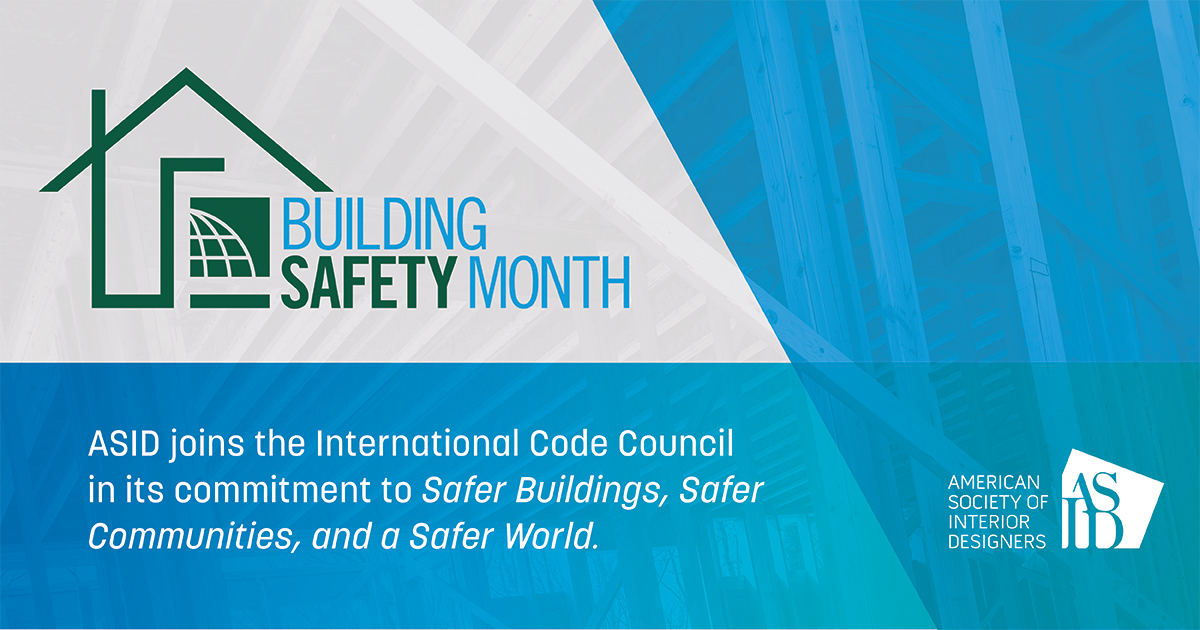ASID joins the International Code Council in its commitment to safer buildings, safer communities, and a safer world.
Thoughtful design can support organizational priorities such as occupant health, productivity, accessibility, and financial return. Certified interior design professionals must master the design guidelines set forth by building codes and standards, and the Americans with Disabilities Act (ADA) to best serve their clients.
Because of the relationship amongst health, safety, welfare, accessibility and design, the Society offers our support for the adoption of the most recent edition of the coordinated family of International Codes (I-Codes). Learn more about Building Safety Month and check back weekly for updated guidelines and resources throughout the month of May. To find out more about ASID's commitment to policy, codes and standards, please email codes@asid.org.
Join ASID in showing your commitment to building safety by signing the online proclamation.
Week 1: Energy and Innovation
Even though sustainability has made significant inroads into the everyday vernacular, we can and need to do more. Green building and sustainable design strategies reinforce the societal health, life and safety benefits that building codes and standards offer. They provide strategies to cope with a changing climate, resource consumption and management, and offer resilience to natural disasters. Aside from the obvious benefits for the health, safety, welfare, and comfort of building occupants, sustainable choices save money, and preserve resources at every stage of a building's lifecycle. ASID joins the ICC with these suggestions and resources for living and building green:
Professional interior designers work in an integrated model of collaboration and use a holistic approach that brings designers, architects, builders, owners, occupants, codes officials, and standards-setting organizations together to make decisions that can have a profound impact on the people who live and work in these spaces and on the environment.
Additional resources and information:
Week 2: Training the Next Generation
Well trained, motivated design and building safety professionals are key to maintaining a successful built environment. A strong educational foundation, coupled with a commitment to continuing education to stay current with the latest developments, skills, are essential to the protection of public health, safety, and welfare.
The path to becoming a professional, NCIDQ-Certified interior designer includes formal education, thousands of hours of paid, supervised experience, and passage of an internationally-recognized, eleven-hour certification exam to test professional competency in codes, building systems, construction standards, contract administration, design application, professional practice and project coordination.
- NCIDQ-Certified Interior Designers: Highly Qualified Design Professionals
- NCIDQ Exam Components
- Definition of Interior Design
NCIDQ-Certified Interior Designers are eminently qualified to independently design non-loadbearing, non-seismic, and non-structural interior design elements in code-regulated spaces.
Additional resources and information:
Week 3: Water Safety
Clean water is the world’s most precious commodity. At least 2/3 of the U.S. has experienced or is expected to experience water shortages. Drinking water is a persistent problem in every part of the world. Reducing the amount of water we use and protecting water quality are key objectives in safe, sustainable buildings and an important component of operations through and following a disaster. ASID joins the ICC with these suggestions and resources about water safety:
- Facility.net: Water Conservation and Restroom Design
- FEMA Fact Sheet: How to Make Your Water Safe to Drink
One of the easiest ways to improve water conservation is to improve the efficiency of kitchen and bath fixtures. If every household in America installed a water-efficient faucet, the U.S. could save 60 billion gallons of water annually. A small office with as few as 10 employees can save about 69,000 gallons of water and $420 in water utility bills in a single year if they replace just one toilet. Scale that up to a 500-room hotel, and you get a sense of the impact Interior Designers have on their clients’ budget as well as the environment as a whole.
Here are some helpful links to water-related codes and standards used by interior designers:
Week 4: Disaster Preparedness
Natural disasters are increasing in severity and frequency in the world around us. Advance planning for devastating events like hurricanes, floods, tornadoes, earthquakes, structure fires, wildfires, and even outbreaks of infectious diseases help individuals and communities increase the health and safety of their population during a disaster, protects the local tax base, ensures continuity of essential services and supports a faster recovery in the aftermath of a disaster. ASID joins the ICC with these suggestions to help your family and community:
- Build to the latest codes
- Prepare your family
- Protect your home
- Benchmark your community’s resilience
One of the best ways for communities to prepare for disasters is to build to the latest building codes. Professional interior designers are trained to properly apply codes and stay up-to-date with code advancements through continuing education. They work with building officials and other qualified professionals to safeguard the health, safety, and welfare of all building occupants.
Here are some helpful links to interior design-related codes:

